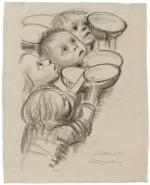
Focusing on the Future. Evoking Memories of German Hunger
Responding to this year’s World Food Day theme ‘Our actions are our future’, the museum chose one of Kollwitz’s most famous works Deutschlands Kinder Hungern! (Germany’s Children are Starving!), which was made in 1923 for the Workers International Relief. Depicting hungry children holding up their bowls, their large hollow eyes eagerly seeking ways to relieve their hunger, Kollwitz sought to draw attention to the devastating hardships experienced in Germany after the First World War.
Making a past period of hunger relevant to the present
In showcasing the vulnerable position of children in times of deprivation, the museum’s Instagram post emphasized that Kollwitz’s drawing is highly relevant for today’s world, in which ‘every thirteen minutes a child under the age of 5 dies as a result of acute malnutrition’. In this way, memories of hunger related to WWI intersect and resonate with current-day issues of food scarcity across the globe.
The renewed engagement with German hunger memories illustrates that a hunger period from almost a hundred years ago still plays a role in the present. Through using the image, the museum draws attention to its collection; more importantly, however, the present power of the drawing historicizes contemporary children’s suffering. Through this process, modern hunger becomes embedded in a long-term perspective on continued scarcity.
Memories of hunger change with each act of recall
If present-day issues such as World Food Day make German hunger current and relevant, what does this mean for the ways this hunger period is remembered? What effect does the more recent context in which memories of German hunger are evoked have on our recollection of this past?
When we examine the history of the ways in which Kollwitz’s Deutschlands Kinder Hungern! has been evoked, one thing stands out: memories of this period of hunger change with each act of recall. For example, the illustration featured in East-German schoolbooks in 1967 and 1988. During the Cold War, Educational material from the GDR was strongly politicized. By placing current and past conditions of scarcity in the context of the capitalist oppression of the working classes, hunger memories were used for socialist purposes. As such, in these textbooks German hunger conditions related to WWI were predominantly used to demonstrate the capitalist exploitation of the working classes. As a logical consequence, this does not leave our perspectives on this history untouched: connecting this hunger period to present issues reshapes our memories of this past and inscribes this past with new values.
Another example can be found in the 2014 exhibition ‘Warning and Temptation’ (Mahnung und Verlockung) at Berlin’s Käthe Kollwitz Museum. By linking Kollwitz’s work on hunger and suffering with the work of the contemporary Hungarian artist Kata Legrady on the workings of war propaganda, the exhibition demonstrated that German hunger legacies can take on a more universal meaning. They now functioned as warnings against war and its disastrous consequences for humanity: whereas Kollwitz’s image was originally used to visualise specifically German victims of food shortages, within this new pacifist framework the importance of the national framework is pushed to the background, whereby the more general concept of war-related suffering is foregrounded.
Tangible memories
Similarly, the 2021 recalling of German hunger related to WWI within a World Food Day discourse gives new meanings to this history. Here German hunger is also detached from its specific national framework and embedded in a larger, extended and transnational discourse of suffering from hunger. However, this time the narrative does not focus on hunger as a consequence of war, but on food scarcity as a phenomenon with specific effects on children. The history of the uses of German hunger memory demonstrates that the selective ways in which this hunger period is utilized, are informed by present and future concerns. Seen from this perspective, it seems that ‘our actions are not only our future’; they also showcase our memories.
This blogpost was originally published on the Heritages of Hunger project website, October 21, 2021.
